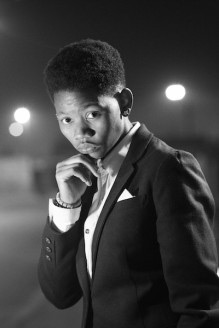
| HOME |
| NERVE |
| REVIEWS |
| ARCHIVE |
| EVENTS |
| LINKS |
| ABOUT US |
| CONTRIBUTORS |
| BACK ISSUES |
| CONTACT US |
Zanele Muholi: Vukani/Rise
 Open
Eye Gallery
Open
Eye Gallery
Till 29th November 2015
Reviewed by Ashley McGovern
Zanele Muholi is an internationally renowned photographer and political activist who uses her classically styled portraits to illustrate LGBTI life in South Africa. Open Eye Gallery has gathered selections from four important series in Muholi’s output, moving between personal under the covers privacy to public declarations of sexuality:
Zava (2013-14): an intimate series of Muholi and her lover Valerie in various rooms across Europe. A blurry circular iris around the edges distorts the room and reveals the couple in sensual embrace in the centre.
Another few images depict the artist lost in the pristine white swirls of a duvet, curling her hair with her finger.
In 2014 Muholi collaborated on a video-performance piece where scenes of passionate queer love changed to a row of candle-bearing women in mourning. On the screen was projected “Sifela i Ayikho” (translates as “We are being killed for nothing”) and harsh rock music was played to drown out the doleful singing. Performers intrude on the cinematic experience to assemble bricks inscribed with the names of those who have died as the result of racial hate. Intimate views and public, devoutly political grief, are intertwined constantly in her work.
Faces and Phases (2006-2014): taken from a larger book form of around 250 pictures (shortlisted for the prestigious Deutsche Borse Photography Prize 2015), these 185 portraits depict the gay community in a proud and highly fashionable wall of fame style. The mood of the people ranges from sombre thoughtfulness, a seriousness reflecting the ongoing homophobic hatred towards African gays, to the confident fashionistas in retro outfits with chic bow ties.
Mo(u)rning (2014): a collection of photographs showing the mournful rituals during LGBTI funerals. A circle of women tip their red candles together in a coven-black, undefined space. The glimmering colours are a reminder that lesbian funerals can be colourful affairs.
Black, however, is the sign of unceasing hatred, a climate of fear. When exhibited in Johannesburg, this series, originally titled Of Love and Loss, also included a transparent glass coffin filled with cotton buds and funeral flowers in the centre of the gallery.
Brave Beauties (2013-14): a brilliant sequence of feminine gay and transgender men who pose in black lingerie in the style of fashion shoots.
In the upper gallery there is a film about a black lesbian wedding which is fascinating in connection with the material downstairs.
Muholi’s photographs are political and she identifies more as a ‘visual activist’ than traditional fine artist. She records, even stylistically brands, the present with a glamorous eye, something which is continued in her other media forms, like the website Inkanyiso. Inkanyiso (meaning “the one who illuminates”) not only publishes personal coming out stories, prints photographs from the vibrant gay pride festivals across South Africa and advertises the work of other female artists, but also documents the sadistic responses to such proud homosexuality, like posting updates of the trials of men who are convicted of vile attacks.
Muholi has said “look at the photographs, read the biographies” and the two acts, switching between the stylish poise of her portraits and the harrowing tales of persecution gathered on her website, are essential. Perhaps the gallery could project Inkanyiso onto the gallery wall and allow people to scroll through; it’s such an important site.